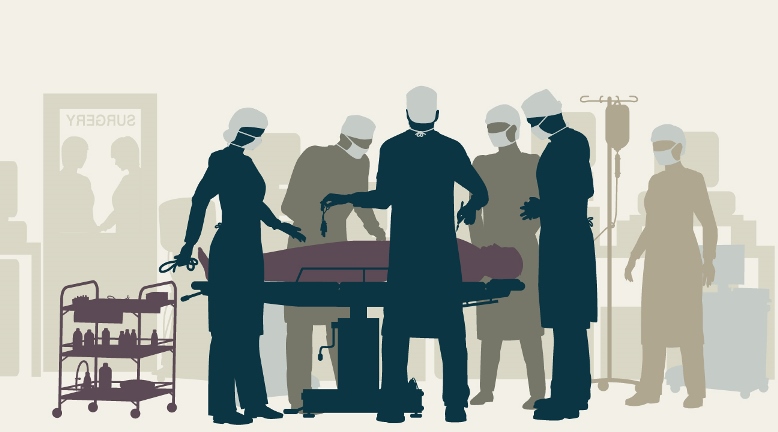Rethinking Surgical Safety
Less Last-Minute Scrambling Improves Safety for Surgical Patients
Anticipating surgery is nerve-racking enough for a patient and her family—and that’s without added worries that her operating room (OR) team might be feeling frantic in the moments leading up to her procedure.
 According to URMC Chief Quality Officer Bob Panzer, M.D., cultivating calm and order is critical. “The surgical team needs to be prepared ahead of time,” he says. “Rushing around beforehand is a lot like speeding in a car. You just aren’t as safe as you could be.”
According to URMC Chief Quality Officer Bob Panzer, M.D., cultivating calm and order is critical. “The surgical team needs to be prepared ahead of time,” he says. “Rushing around beforehand is a lot like speeding in a car. You just aren’t as safe as you could be.”
Eager to “slow down” and spend time where it matters most, UR Medicine’s Perioperative faculty and staff have joined forces with their academic medical colleagues from MCIC Vermont, a hospital-owned liability insurer. MCIC provides coverage to UR Medicine and four other influential northeast health systems, including those affiliated with Johns Hopkins, Yale, Cornell, and Colombia universities. And because MCIC doubles as a risk-reduction consortium, these five systems—which boast 18 combined hospitals—frequently team up for safety-improvement projects.
“MCIC’s experts are passionate about safety,” Panzer said. “They keep a keen eye on claims data from Strong, Highland, and the sixteen other member hospitals. They want to spot trends as soon as possible.”
And last fall, MCIC clued its partners into a troubling one: Across the board, the number of surgical claims was creeping upward.
Room for Improvement
Eager to understand what might be causing the uptick, MCIC deployed a team of outside expert nurses and surgeons from the Institute for Healthcare Improvement (IHI) to tour ORs at the member hospitals. Consultants paid special attention to patient flow, sterilization and infection prevention practices, team work dynamics, and the overall culture.
“We see this project as a great opportunity for improvement,” said Richard N. Wissler, M.D., Ph.D., who serves as Medical Director for Perioperative Services at Strong. “Past MCIC-sponsored safety initiatives in other clinical areas have improved both care quality and the workplace environment. We’re optimistic this one will achieve similar advances in the perioperative area.”
An earlier MCIC project targeting safer newborn deliveries, for instance, cut Strong’s obstetrics-related malpractice claims by nearly half. Other fruitful MCIC collaborations include work avoiding in-hospital falls and enhancing Emergency Department safety.
The Game Plan
Armed with data from the IHI tours, UR Medicine and its MCIC partners commenced the “Periop Safety Initiative.” So far, the safety team—comprised of surgeons, anesthesiologists, and OR nurses—has focused on systems redesigns, including:
-
Pre-surgical medical evaluations, to improve patient-friendliness, and to make sure a patient is as stable as possible—or “medically optimized”—for surgery, and,
-
Better solutions for information management. For the best care-planning, all of the necessary preoperative data should flow seamlessly to a single location that’s easily accessed by all members of the surgical health care team prior to surgery.
“This project has significant challenges,” Wissler admits. “It means restructuring the important preparation work—consultations, paperwork, prophylaxis plans, etc.—that happens in the days before surgery. Fortunately, we have a large group of talented and enthusiastic professionals working on the project, both here and at our MCIC partner hospitals. Interestingly, all of us are reporting similar challenges with our preoperative systems, including information management.”
 According to Wissler, part of the effort at UR Medicine involves partnering with in-house computer programmers to build e-tools—like a new surgery information template that would spell out a patient’s surgical plan, findings, and instructions for post-operative care. This template, together with signed consent documents, would be conveniently filed in the patient’s e-chart.
According to Wissler, part of the effort at UR Medicine involves partnering with in-house computer programmers to build e-tools—like a new surgery information template that would spell out a patient’s surgical plan, findings, and instructions for post-operative care. This template, together with signed consent documents, would be conveniently filed in the patient’s e-chart.
“Information comes to us piecemeal now, so it’s hard to keep organized,” Wissler said. “E-tools should reduce last-minute running around. It’s an efficiency issue and a safety issue.”
Besides the Peri-Op Safety Initiative, UR Medicine is knee-deep in other surgical safety projects, including:
-
More faithfully huddling. No matter how harried the schedule, teams have renewed their focus on taking time-outs before a procedure even begins. According to Pat Reagan Webster, Ph.D., an associate quality officer at Strong Memorial, “You want to make sure you’ve got your ‘rights’ straight: the right surgery on the right patient in the right location. It seems obvious, but it’s crucial to double-check.” Huddling after a procedure, too—to debrief, or to run through final safety checks—is equally important.
-
Standardizing prophylaxis. As part of the effort, we’re standardizing our approach to preventive antibiotics (bacteria-killing drugs given to ward off potential infections). We’re spelling out which medications—in which quantities—are indicated for each procedure.
-
Avoiding flash-sterilization. Advance sterilization of tools is the most thorough technique for killing germs, but when ORs compete for resources, teams sometimes leverage a speedier “flash-sterilization.” More strategic OR scheduling, so that equipment needs are spread over larger time periods, will lessen dependence on just-in-time sterilization.
-
Staving off surgical site infections (SSIs). In addition to more rigorous guidelines around antibiotics and equipment sterilization, a dedicated SSI team is promoting best-practices, like proper skin cleansing, and maintaining a consistent body temperature and blood glucose level in each patient.
-
Forging tighter teams. We’re paying special attention to healthy team dynamics. “We want to foster cooperation, trust, and respect,” Reagan Webster said. “For teams to work safely, everyone—from the tech to the lead surgeon—needs to be empowered to speak up.” Offerings to fortify teams include: training curriculum (e.g., TeamSTEPPS), professional motivational speakers, and as-needed skills-coaching for providers and staff (e.g., bedside manner, the art of “crucial conversations,” etc.). OR schedulers also are trying to keep smooth-running teams together. And experts are looking at ways to tighten communication during “hand-offs”—that is, care transitions, such as when a patient leaves the OR for the PACU (post-anesthesia care unit), or leaves the PACU for the ICU.
“None of these are novel concepts,” Reagan Webster said. “But we need to make a concerted effort to be more highly reliable, doing all the right things all of the time.”
The Periop Safety Initiative, which officially kicked off in December 2013, represents a multi-year effort.
10/29/2014
You may also like